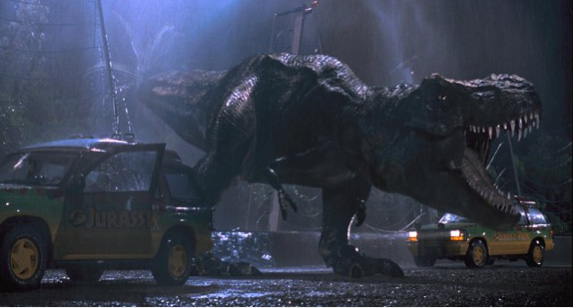T. Rex at 20: How 'Jurassic Park' Science Has Evolved

With a 3D version in the theaters and a sequel due out next year, the now-classic "Jurassic Park" will roar into its 20th anniversary on June 11.
Two decades might seem like the blink of a lizard's eye on top of 65 million years, but the science and speculations of "Jurassic Park" have evolved significantly since Steven Spielberg's beasts first shook movie theaters.
Here are seven ways the science of Tyrannosaurus rex and company has changed since audiences first heard, "Welcome to Jurassic Park!"
1. Plumed T. rex?
If filmed today, the science suggests many of "Jurassic Park" dinos would look a bit more Tweety Bird than Terrible Lizard. The first film hewed to the long-standing image of dinosaurs as big, scaly reptiles. Subsequent research, however, has provided more and more evidence that many meat-eating dinosaurs sported plumage. A year ago, scientists in China unearthed a feathered Tyrannosaur — Yutyrannis huali — a slightly smaller relative of T. rex. Velociraptors also clearly had feathers, confirmed by the discovery of quill knobs, a type of feather anchor, on raptor arm bones in 2007.
This was suspected even at the time of the 1997 sequel, "The Lost World," however. Spielberg made a gesture toward the science by putting a few feathers on his speedy killers in that film, though not as many as the paleontologists requested. If he had, the raptors would have looked too different from the first film, said Jack Horner, a renowned paleontologist at Montana State University and a technical adviser on all the "Jurassic Park" films. Next year's fourth "Jurassic Park" film, however, will keep the dinos scaly, according to reports — despite what experts say.
2. A mammoth boost to cloning?
Sign up for the Live Science daily newsletter now
Get the world’s most fascinating discoveries delivered straight to your inbox.
Back when "Jurassic Park" debuted, science was still three years away from the arrival of the sheep named "Dolly," the first cloned adult animal, and a landmark in cloning technology. In 2001, scientists replicated the first endangered species — "Noah" the guar, a type of threatened ox. Since then, cloning and genetic technologies have continued to advance, with some researchers turning their attention to extinct species. Now, new genetic tools, and well-preserved specimens, could make one "Jurassic Park"-esque feat a reality: cloning a mammoth. Last year, a South Korean and Russian team announced their goal of doing just that. [6 Extinct Animals That Could Be Resurrected]
In the film, a fictional educational cartoon credits "thinking machine supercomputers and gene sequencers" with reading dinosaur DNA. But no technology in 1993 could have done that kind of massive genetic analysis. In 2005, however, the 454 Life Science Genome Sequencer made it possible to do just the sort of large-scale reads and analyses shown in the film. "The change in technology really sparked our ability to deep sequence these extinct species," said Hendrik Poinar, an evolutionary biologist at McMaster University in Ontario who is studying mammoth DNA. With well-preserved mammoth tissue unearthed from the icebox of Siberia and the Yukon, Poinar and colleagues have sequenced the DNA of the extinct elephant relatives. "We completely underestimated how long it would take before we could sequence those genomes," Poinar told LiveScience. "Some thought we never would."
Cloning a mammoth is now conceivable, Poinar said. The film correctly predicted the need to repair ancient DNA, which degrades over time, and use modern relatives to bring extinct babies to term. In "Jurassic Park," scientists plugged holes in degraded dino DNA with substitutes from frogs, incubating the extinct animals' embryos in emu and ostrich eggs. Similarly, current or near-current science could repair the fragmented genetic material of mammoths using elephant templates, and implant an embryo in an elephant womb. Ensuring that the elephant could bring a mammoth embryo to term poses the next challenge, but much of the science is in place — such as synthesizing long sequences of DNA and modifying cells to be pluripotent stem cells, which can turn into any cell in the body, Poinar said. He predicts a cloned mammoth within 10 to 50 years. "We're closer and closer than we ever expected to be," he said. "People with enough money will absolutely do it."
3. Orange Dino? Blue Dino?
In April, scientists made the remarkable discovery of intact dinosaur skin, which could reveal the hues dinosaurs came in — perhaps far beyond the green and brown traditionally portrayed. Though three other samples of dinosaur skin have been discovered, scientists are now, for the first time, using particle accelerators to probe the samples for pigments, said Mauricio Barbi, a physicist at the University of Regina, who discovered and is investigating the sample. The test could reveal the shapes of cell structures called melanosomes, and different shapes are associated with different pigments, Barbi said. The research has already shown high concentrations of copper and zinc, suggestive of the presence of melanin, a common pigment that all melanosomes contain. [Paleo-Art: Dinosaurs Come to Life in Stunning Illustrations]
Even without direct skin analysis, current evidence says dinosaurs used up more of the crayon box than historically assumed. Since the early 1990s, the evidence linking the evolutionary branches of dinosaurs and birds (as well as lizards) has gotten all the more convincing. Birds and lizards show a lot of colors, so scientists would expect dinosaurs to do so, as well, said Horner. Even at the time of the first "Jurassic Park," Horner argued for brighter beasts. But Spielberg wanted more frightening, dragonlike shades. "I wanted them more colorful," Horner said. "Steven wanted them scary."
4. Birds descended from dinos? Yawn
The scientists of "Jurassic Park" argue energetically that dinosaurs evolved into birds. In the film, paleontologist Alan Grant excitedly notes the swift-running Gallimimus pack moving together "like a flock of birds evading a predator!" But by now, the family ties between birds and dinosaurs are pretty much conventional wisdom.
Back in 1993, though, bird-dino relationships were a sufficiently new idea, and contentious enough, to serve as both a point of scientific debate and a sort of redemptive conclusion; even though they ate many of his friends, the dinosaurs confirmed Grant's ideas about bird descent. The evidence linking dinosaurs to birds in 1993 came from skeletal resemblances, mostly compiled in the 1980s. "Back then, it was based solely on bone structure," said Luis Chiappe, a paleontologist at the Natural History Museum at Los Angeles who specializes in dinosaur evolution. "In the last 20 years, we've had so many lines of evidence telling us the same thing." Feathered dinosaurs, commonalities among dinosaur peepers and bird eyes, and similarly structured eggs all point to dinosaur-to-bird descent, Chiappe added. By estimating cell sizes based on spaces in bones, scientists have even calculated that theropod dinosaurs (those most closely related to birds) had genomes of approximately the same, small size as birds.
As a result, it's much harder now to deny that birds came from T. rex and kin. "Today, you would have to explain how they're so similar in so many ways," Chiappe said.
5. Warm and cuddly creatures
In a similar redemption of the "Jurassic Park" scientists' theories, the reborn dinosaurs appear warm-blooded, notably demonstrated when the Velociraptor's breath steams up a window. Scientists' early perception of dinosaurs as big crocodiles also portrayed them as cold-blooded, slow-moving brutes at about the same time. Evidence has piled up in this area, too, since 1993, Horner said, though it was fairly established back then, too. "For the last 20 years, we've known dinosaurs were warm-blooded," Horner said. "We've just been getting more and more facts." The vasculature (number of blood vessels, revealed by microscopy of bone structure) and growth rates of baby dinosaurs required warm innards, Horner said. "There's nothing alive today that has the vasculature of a dinosaur [but] that is cold-blooded." [Baby Beasts: Images Reveal Dinosaur Embryos]
6. T. rex the scavenger?
In the last couple of years, a 12-year study detailed in the journal PLOS ONE helped downgrade T. rex from terrifying hunter, capable of chasing down Jeeps filled with mathematicians and children, to a big lug rummaging through the garbage. The research compared relative numbers of T. rex individuals and their purported prey (duck-billed dinosaurs), finding far too many T. rexes for the enormous beasts to be top-level predators. An environment can support about the same number of scavengers, like hyenas, as prey, but far fewer high-level predators, like lions. The conclusion: T. rex doesn't want to hunt, he wants to be fed.
Horner, in fact, first probed the theory of T. rex as scavenger around the time "Jurassic Park" premiered. "I was struck by the idea that the [T. rex] morphology was almost completely the opposite of Velociraptor," Horner said. T. rex had a big head; "big, bone-crushing teeth," and those famously tiny forearms, Horner said. All of this suggested "the Tyrant Lizard King" rummaged for its meat, crunching up carcasses instead of running after prey. "If it hunted at all, it probably just targeted weak, sick or dead animals," Horner said. The movies, unsurprisingly, depict T. rex as a much more active predator.
7. Bad news: DNA decay
If the demotion of T. rex from king to peasantry weren't enough, perhaps the cruelest blow to dino lovers came last year, when researchers determined that "Jurassic Park" would be impossible. The reason? Too much time has passed to recover the terrible lizards' DNA from the blood of petrified insects, as the movie portrays: The molecules would have decayed long ago. Researchers in Australia last year made the first-ever calculation of DNA's half-life, or the time for half of a DNA molecule's bonds to break. By the researchers' calculations, all DNA would disappear, "even under the best scenarios, in 6-7 million years," researcher Mike Bunce, from Murdoch University's Ancient DNA lab in Perth, wrote in an email to LiveScience. That means cloners could still use DNA from the relatively recent woolly mammoth, which survived until a few thousand years ago. But the last T. rex roared 65 million years in the past, and most dinosaurs disappeared much earlier.
"Jurassic Park 4" will go on, of course, sweeping this little scientific hang-up under Hollywood's red carpet. As Horner said, "My job was to make the dinosaurs look as good as they could. Steven turned them into actors." And actors can fib a little.
Follow LiveScience on Twitter @livescience. We're also on Facebook & Google+. Original story on LiveScience.com.

Michael Dhar is a science editor and writer based in Chicago. He has an MS in bioinformatics from NYU Tandon School of Engineering, an MA in English literature from Columbia University and a BA in English from the University of Iowa. He has written about health and science for Live Science, Scientific American, Space.com, The Fix, Earth.com and others and has edited for the American Medical Association and other organizations.









